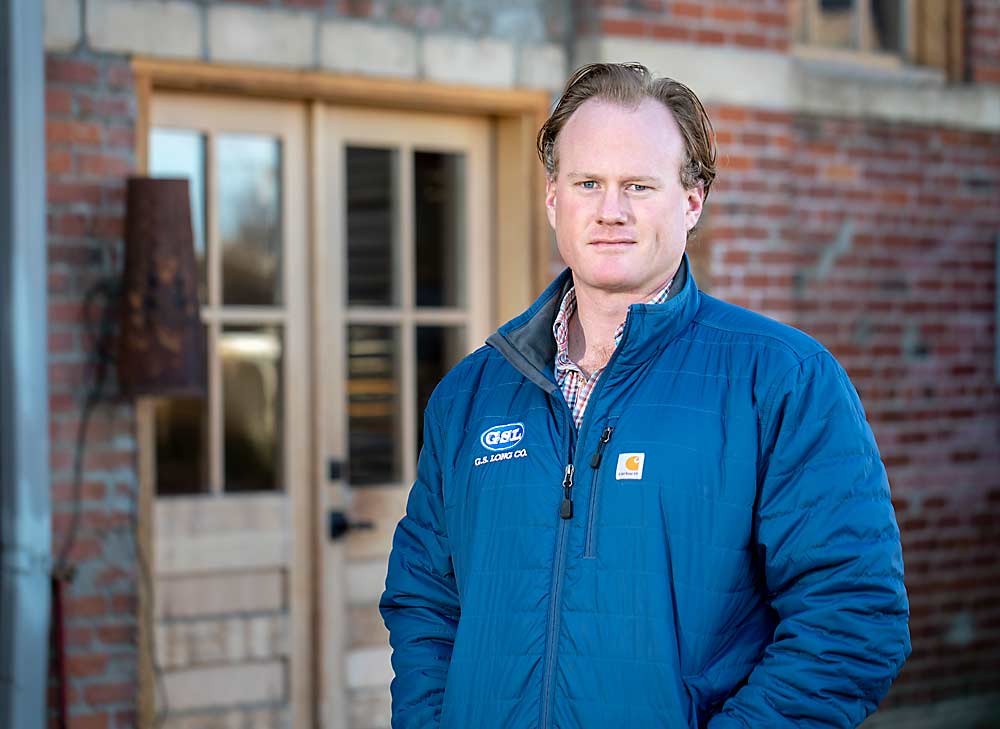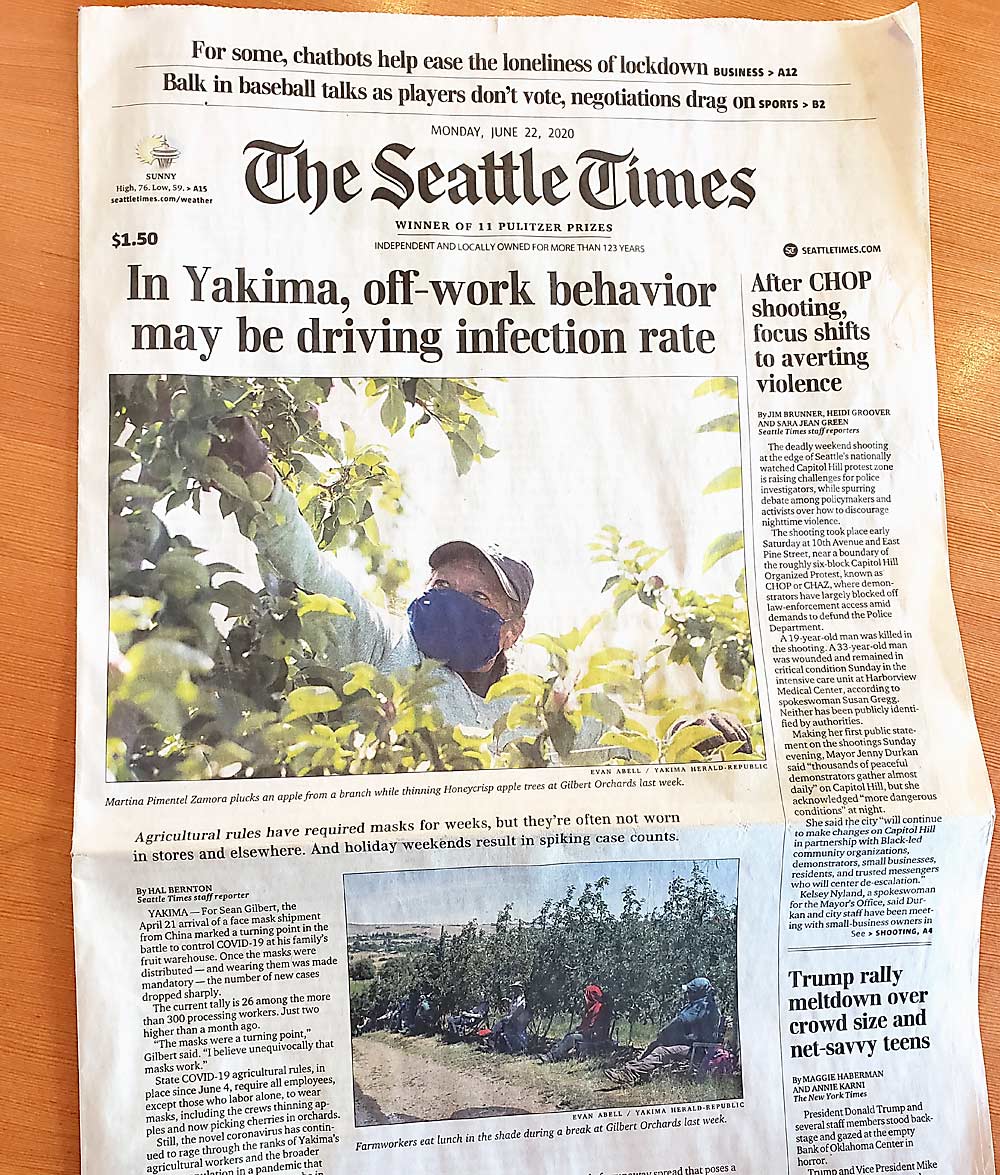
Editor’s note: This story has been updated to include the correct crops Pat Shanahan, executive vice president of Action Mary, grew up farming.
With his picture and comments in The Seattle Times, The Washington Post and The Wall Street Journal, Sean Gilbert became one of the faces of the tree fruit industry’s pandemic response.
It was a little nerve-wracking, he admitted, but not as bad as he feared.
“All things considered, I’m happy with it,” said Gilbert, president of Gilbert Orchards near Yakima, Washington, and a fifth-generation grower.
As the 2020 fruit season picked up steam, so did the spread of the coronavirus and with it pointed questions about how companies protected their essential farmworkers. Gilbert hosted some reporters at his farm, and even though it wasn’t always pleasant, he’s glad he did. In his opinion, the stories painted a nuanced picture of everybody’s struggles to farm their way through uncertainty.
“The situation was tough for anybody,” Gilbert said. “Nothing was cut-and-dry. There were no easy right answers.”
Media experts hired by the tree fruit industry lauded how Gilbert and other fruit companies responded to media scrutiny, and they suggested growers apply some of the same lessons as they brace for 2021:
—Be honest.
—Work with reputable reporters.
—Ask for help.
—Say no when necessary, but explain why.
—Explain situations with detail, context and examples.
—Most importantly, don’t hide.
“Engage, don’t duck,” said Roger van Oosten, content and crisis communications manager and partner for Action Mary, a Seattle public relations company hired by the Washington State Tree Fruit Association, WSTFA, to help manage communications during the pandemic. “Don’t go into a bunker.”
Van Oosten and Pat Shanahan, executive vice president of Action Mary, went over these lessons at WSTFA’s virtual annual meeting in December. Believe that the industry has nothing to hide and carries the “nobility” of feeding the world, Shanahan said. That message will resonate.
“Generally, people like farmers and have a positive perception of farmers,” Shanahan said.
Asking a farmer to embrace the spotlight is a tough sell, they said. But someone has to do it, or critics will control the narrative and the general public will see nothing but headlines and photos about strikes and lawsuits.
“Just doing good and hoping the world will know you’re doing a good thing just isn’t going to happen,” said Shanahan, who grew up working in mint and alfalfa fields. Shanahan also reminded growers to admit when they don’t know something, promise to find out and cop to mistakes right away.
In a follow-up interview, van Oosten added patience to the list of advice. Think about what you want to say before you start speaking, he said. “It’s really bad to talk off the cuff, because you’re affected by emotion.”
The Action Mary team also suggested growers ask for help. WSTFA President Jon DeVaney often acted as spokesman for the industry at large, while individual companies answered questions about their own operations. Action Mary is developing a crisis communications plan for WSTFA, with some lessons growers can apply to their own businesses.
The U.S. Apple Association, based in Falls Church, Virginia, has its own crisis communications plan and keeps on its website one-page fact sheets about industry controversies such as listeria, chlorpyrifos and labor. Called “Backgrounders,” the fact sheets use bullet points and simple language to spell out key facts and statistics underlying the various issues, so the growers don’t have to research the answer to every question. “It’s already been answered,” said Jim Bair, president and CEO.
Meanwhile, a nonprofit called Save Family Farming, based in Lynden, Washington, pens and digitally publishes pro-farmer opinion pieces and critiques news media coverage of agricultural issues. The group’s executive director, Gerald Baron, has a background in crisis public relations management and also spoke at the same WSTFA annual meeting session. The nonprofit recently produced a video of H-2A workers describing what they like about their work in the United States.

Gilbert’s coverage
Over the summer, journalists didn’t exactly pat Gilbert or the industry on the back. They reported that his company and others had outbreaks, quoted union officials about unsanitary toilets and ran pictures of workers at several packing facilities — not Gilbert’s — walking out to seek safer conditions and higher wages.
But the stories also included the fact that Gilbert spent $22,000 in April to buy 16,000 masks for his employees, noted the measures packing houses took to separate workers and quoted health officials blaming a lot of the virus’ spread on community transmission, not workplace infections.
“Reputable media want to get the story right,” said van Oosten, a former reporter for the Boston Globe and KING-TV in Seattle.
Gilbert didn’t say yes to every media request. He turned down several interviews, either because he was too busy or industry groups didn’t recommend the reporter. The photographers and writers who did visit his farm asked to see inside housing units and packing facilities. Gilbert declined because the company wasn’t allowing any visitors inside, to reduce COVID-19 risks, and was strongly discouraging its own growers from visiting.
Gilbert was the chair of WSTFA at the time of the coverage and felt a responsibility to stick his neck out a little. His ancestors, too, took their turns speaking on behalf of the industry in times of controversy, he said. He’s also been through some of it before, appearing in interviews with The Seattle Times on legislative issues, for example.
Part of him likes the attention, he admitted. Another part of him wants others to take a turn next time.
“Any grower can do it,” he said. “I hope I can inspire other growers to do it, too.” •
—by Ross Courtney






Leave A Comment